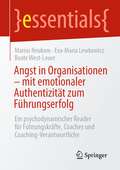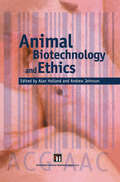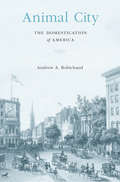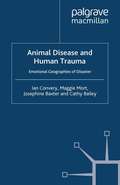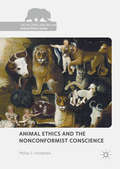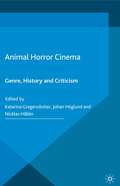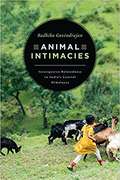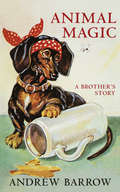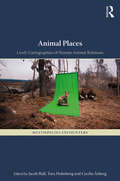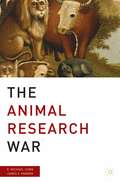- Table View
- List View
The Angola Prison Seminary: Effects of Faith-Based Ministry on Identity Transformation, Desistance, and Rehabilitation (Innovations in Corrections #1)
by Michael Hallett Joshua Hays Byron R. Johnson Sung Joon Jang Grant DuweCorrections officials faced with rising populations and shrinking budgets have increasingly welcomed "faith-based" providers offering services at no cost to help meet the needs of inmates. Drawing from three years of on-site research, this book utilizes survey analysis along with life-history interviews of inmates and staff to explore the history, purpose, and functioning of the Inmate Minister program at Louisiana State Penitentiary (aka "Angola"), America’s largest maximum-security prison. This book takes seriously attributions from inmates that faith is helpful for "surviving prison" and explores the implications of religious programming for an American corrections system in crisis, featuring high recidivism, dehumanizing violence, and often draconian punishments. A first-of-its-kind prototype in a quickly expanding policy arena, Angola’s unique Inmate Minister program deploys trained graduates of the New Orleans Baptist Theological Seminary in bi-vocational pastoral service roles throughout the prison. Inmates lead their own congregations and serve in lay-ministry capacities in hospice, cell block visitation, delivery of familial death notifications to fellow inmates, "sidewalk counseling" and tier ministry, officiating inmate funerals, and delivering "care packages" to indigent prisoners. Life-history interviews uncover deep-level change in self-identity corresponding with a growing body of research on identity change and religiously motivated desistance. The concluding chapter addresses concerns regarding the First Amendment, the dysfunctional state of U.S. corrections, and directions for future research.
Angry Abolitionists and the Rhetoric of Slavery: Moral Emotions in Social Movements (Cultural Sociology)
by Benjamin Lamb-BooksThis book is an original application of rhetoric and moral-emotions theory to the sociology of social movements. It promotes a new interdisciplinary vision of what social movements are, why they exist, and how they succeed in attaining momentum over time. Deepening the affective dimension of cultural sociology, this work draws upon the social psychology of human emotion and interpersonal communication. Specifically, the book revolves around the topic of anger as a unique moral emotion that can be made to play crucial motivational and generative functions in protest. The chapters develop a new theory of the emotional power of protest rhetoric, including how abolitionist performances of heterodoxic racial and gender status imaginaries contributed to the escalation of the ‘sectional conflict’ over American slavery.
Angst in Kultur und Politik der Gegenwart: Beiträge zu einer Gesellschaftswissenschaft der Angst (Kulturelle Figurationen: Artefakte, Praktiken, Fiktionen)
by Susanne Martin Thomas LinpinselAngst ist nicht nur eine menschliche Grundemotion, sondern ein gesellschaftliches Phänomen. Jüngst wurde sie zum charakteristischen Gefühl westlicher Gegenwartsgesellschaften erklärt und insbesondere mit politisch regressiven Entwicklungen, allen voran dem Aufstieg des Rechtspopulismus, in Verbindung gebracht. Ausgehend von Befunden eines aktuell veränderten gesellschaftlichen Stellenwerts der Angst untersucht der Sammelband in interdisziplinärer Perspektive gegenwärtige Ursachen, Auswirkungen, Repräsentationen, Ausprägungen, Deutungen und Praktiken der Angst. Mithilfe unterschiedlicher konzeptueller, theoretischer und methodisch-empirischer Zugänge werden im Sinne einer interdisziplinären Gesellschaftswissenschaft der Angst die vielfältigen sozialen, politischen und kulturellen Bedeutungen der Angst in gegenwärtigen Gesellschaften beleuchtet.
Angst in Organisationen – mit emotionaler Authentizität zum Führungserfolg: Ein psychodynamischer Reader für Führungskräfte, Coaches und Coaching-Verantwortliche (essentials)
by Marius Neukom Eva-Maria Lewkowicz Beate West-LeuerUnliebsame Gefühle sind Merkmale konstruktiv authentischen Führens. Führungskräfte, die Angst erleben und reflektieren können, verfügen über Vorteile. Denn Angst ist nicht nur ein Schlüssel zur Ausbildung von Selbstkenntnis, sondern auch zur Förderung von Motivation, Zusammenarbeit und Veränderungsbereitschaft. In der Arbeitswelt wird Angst jedoch vermieden und tabuisiert, weil sie Abneigung erzeugt und als hemmend erlebt wird. Dieser Leitfaden macht dieses essenziell menschliche Gefühl zugänglich, erläutert seine unvermeidliche, gesunde wie auch krank machende Seite und zeigt Wege auf, wie es sinnvoll und produktiv in Führungsarbeit und Organisationsentwicklung integriert werden kann.
Angst und Angstpolitik: Interdisziplinäre Perspektiven (Studien zur Inneren Sicherheit)
by Jens Lanfer Martin W. SchnellDieses Buch untersucht das Phänomen der gesellschaftlichen Angst und die hierauf ausgerichtete Angstpolitik. Die Angst in der Gesellschaft wird von vielen sozialwissenschaftlichen Untersuchungen angeführt, bleibt aber theoretisch und vor allem analytisch auffällig unbestimmt. Dies gilt ebenso für gesellschaftliche Diskurse: Ob nun alltägliche Unsicherheiten oder die Furcht, Sorge oder Angst gemeint sind, bleibt entweder unklar oder die Begriffe werden synonym verwendet. Das Buch setzt sich deshalb zum Ziel, verschiedene Formen der Unsicherheit in der Gesellschaft deutlicher zu bezeichnen, um soziale und politische Bedingungen und Folgen von Angst genauer fassen zu können. Die Beiträge der Autor*innen reflektieren aus unterschiedlichen Disziplinen (Geschichtswissenschaft, Philosophie, Politikwissenschaft, Soziologie) und über verschiedene Anwendungsgebiete der Sicherheitspolitik das Angstphänomen. Das Buch richtet sich an Forscher*innen, die das Phänomen der gesellschaftlichen Angst theoretisch, analytisch und empirisch untersuchen möchten.
Angstsprachen: Interdisziplinäre Zugänge zur kommunikativen Auseinandersetzung mit Angst
In diesem Sammelband werden die vielfältigen Zusammenhänge von Angst und Sprechen untersucht: die Merkmale, Möglichkeiten und Grenzen der Vermittlung von Angst in Gesprächen, Literatur und Film sowie in bestimmten sozialen und historischen Konstellationen. Dabei geht es darum, wie Erfahrungen der Angst sowohl auf individueller wie auch auf kollektiver Ebene zur Sprache gebracht werden können. Hierzu präsentieren die Beiträgerinnen und Beiträger aktuelle Ansätze der Linguistik, Literatur-, Film-, Medien- und Geschichtswissenschaft sowie der Psychologie, Neurologie und Soziologie. Diskutiert werden innovative Wege der Diagnostik und Therapie sowie der Diskursanalyse und ästhetischen Analyse, die sich auf das Sprechen und Verständigen über Angst beziehen, ebenso wie auf das angstinduzierte Verstummen und Schweigen.
Angstzonen: Rechtsdominierte Orte aus medialer und lokaler Perspektive (Analysen zu gesellschaftlicher Integration und Desintegration)
by Uta DöringDie Studie untersucht die Erscheinungsformen rechtsextremer Dominanz im öffentlichen Raum („Angstzonen“). Auf der Basis von Feldbeobachtungen und Interviews mit den wichtigsten lokalen Akteuren wird das Auftreten rechter Gesellungen an verschiedenen Orten in vier ostdeutschen Städten beschrieben. Eine Medienanalyse rekonstruiert zudem die öffentliche Wahrnehmung dieser als „Angstzonen“ oder „national befreiten Zonen“ beschriebenen Räume.
Aníbal Quijano: Dissidences and Crossroads of Latin American Critical Theory (Classic and Contemporary Latin American Social Theory)
by Deni Alfaro RubboOne of the prominent thinkers in the Social Sciences, Aníbal Quijano (1930–2018), has a fundamental work for the compression of contemporary dilemmas since his main theoretical and political concerns have always been linked to the mutations of world capitalism and its reverse paths. This book aims to contribute with analyses of his voluminous and diversified production distributed practically over 60 years of intellectual trajectory.In the first decades, the Peruvian author produced essential works on peasant movements, the urbanization process, and the class structure in Peru and Latin America by mobilizing sociological categories such as marginality, dependency and structural heterogeneity. He devoted himself to investigating imperialist domination in Peru and its implications for social classes and created the journal Sociedad y Política. In the 1990s and 2000s, the Peruvian sociologist published a set of texts on the coloniality and decoloniality of power, which represents a theoretical construction inseparable from the processes and experiences that were occurring in Peru, Latin America and the world, from the “globalization” of “neoliberalism” to global and local resistances.Thus, this book is addressed to all those, with or without specialized training in social sciences, interested in knowing not only the history of social sciences in Latin America but mainly in understanding the historical roots and the political dilemmas of peripheral capitalist societies.
Aníbal Quijano: Dissidences and Crossroads of Latin American Critical Theory (Classic and Contemporary Latin American Social Theory)
One of the prominent thinkers in the Social Sciences, Aníbal Quijano (1930–2018), has a fundamental work for the compression of contemporary dilemmas since his main theoretical and political concerns have always been linked to the mutations of world capitalism and its reverse paths. This book aims to contribute with analyses of his voluminous and diversified production distributed practically over 60 years of intellectual trajectory.In the first decades, the Peruvian author produced essential works on peasant movements, the urbanization process, and the class structure in Peru and Latin America by mobilizing sociological categories such as marginality, dependency and structural heterogeneity. He devoted himself to investigating imperialist domination in Peru and its implications for social classes and created the journal Sociedad y Política. In the 1990s and 2000s, the Peruvian sociologist published a set of texts on the coloniality and decoloniality of power, which represents a theoretical construction inseparable from the processes and experiences that were occurring in Peru, Latin America and the world, from the “globalization” of “neoliberalism” to global and local resistances.Thus, this book is addressed to all those, with or without specialized training in social sciences, interested in knowing not only the history of social sciences in Latin America but mainly in understanding the historical roots and the political dilemmas of peripheral capitalist societies.
Animal Biotechnology and Ethics
by Alan J. Holland Andrew JohnsonAdvanced biomedical techniques such as genetic engineering are now used extensively in animal related research and development. As the pace of development has quickened, there has been growing public anxiety about the ethical issues involved. Animal Biotechnology and Ethics draws together in one book some of the leading themes and issues which have emerged in the recent debates surrounding biotechnology as applied to animals. With contributions from authors of many different viewpoints, the subject is given a thorough and balanced treatment. Among those to whom the book will be of particular interest are practitioners of animal biotechnology, and those whose interest lies in assessing its credentials, such as philosophers and social or political scientists. It also has a great deal to interest policy-makers and pressure groups, as well as more general readers. The strong chapters on the legal and regulatory framework will make it useful to those involved in advising on company policy, patenting or litigation.
Animal City: The Domestication of America
by Andrew A. RobichaudAmerican urbanites once lived alongside livestock and beasts of burden. But as cities grew, human–animal relationships changed. The city became a place for pets, not slaughterhouses or working animals. Andrew Robichaud traces the far-reaching consequences of this shift—for urban landscapes, animal- and child-welfare laws, and environmental justice.
Animal Creativity and Innovation (Explorations in Creativity Research)
by James C. Kaufman Allison B. KaufmanAnimal Creativity and Innovation explores theories and research on animal innovation and creativity, comparing and contrasting it with theory and research on human creativity and innovation. In doing so, it encompasses findings from psychology, biology, neuroscience, engineering, business, ecology, and education. The book includes examples of animal innovation in parrots, dogs, marine mammals, insects, and primates, exploring parallels from creative play in children. The book defines creativity, differentiating it from play, and looks at evolutionary models and neurological constructs. The book further explores applied aspects of animal innovation and creativity including tool use and group dynamics, as well as barriers to creativity. The final chapters look into how creative behavior may be taught or trained. Each chapter is followed by a commentary for integration of thoughts and ideas between animal and human research, behavioral and cognitive research, and theory and observation in real life.Compares theory and research on animal and human creativityDefines and differentiates creativity from playReviews applied creativity in tool use and social dynamicsIncludes examples of animal creativity in multiple species
Animal Disease and Human Trauma: Emotional Geographies of Disaster
by I. Convery M. Mort J. Baxter C. BaileyMany disasters are approached by researchers, managers and policymakers as if they have a clear beginning, middle and end. But often the experience of being in a disaster is not like this. This book offers non-linear, non-prescriptive ways of thinking about disasters and allows the people affected by disaster the chance to speak.
Animal Ethics and the Nonconformist Conscience (The Palgrave Macmillan Animal Ethics Series)
by Philip J. SampsonThis book explores the religious language of Nonconformity used in ethical debates about animals. It uncovers a rich stream of innovative discourse from the Puritans of the seventeenth century, through the Clapham Sect and Evangelical Revival, to the nineteenth century debates about vivisection. This discourse contributed to law reform and the foundation of the RSPCA, and continues to flavour the way we talk about animal welfare and animal rights today. Shaped by the "nonconformist conscience", it has been largely overlooked. The more common perception is that Christian “dominion” authorises the human exploitation of animals, while Enlightenment humanism and Darwinian thought are seen as drawing humans and animals together in one "family". This book challenges that perception, and proposes an alternative perspective. Through exploring the shaping of animal advocacy discourses by Biblical themes of creation, fall and restoration, this book reveals the continuing importance of the nonconformist conscience as a source to enrich animal ethics today. It will appeal to the animal studies community, theologians and early modern historians.
Animal Horror Cinema: Genre, History and Criticism
by Johan Höglund Katarina Gregersdotter Nicklas HållénThis first full-length scholarly study about animal horror cinema defines the popular subgenre and describes its origin and history in the West. The chapters explore a variety of animal horror films from a number of different perspectives. This is an indispensable study for students and scholars of cinema, horror and animal studies.
Animal Intimacies: Interspecies Relatedness in India's Central Himalayas (Animal Lives)
by Radhika GovindrajanWhat does it mean to live and die in relation to other animals? Animal Intimacies posits this central question alongside the intimate—and intense—moments of care, kinship, violence, politics, indifference, and desire that occur between human and non-human animals. Built on extensive ethnographic fieldwork in the mountain villages of India’s Central Himalayas, Radhika Govindrajan’s book explores the number of ways that human and animal interact to cultivate relationships as interconnected, related beings. Whether it is through the study of the affect and ethics of ritual animal sacrifice, analysis of the right-wing political project of cow-protection, or examination of villagers’ talk about bears who abduct women and have sex with them, Govindrajan illustrates that multispecies relatedness relies on both difference and ineffable affinity between animals. Animal Intimacies breaks substantial new ground in animal studies, and Govindrajan’s detailed portrait of the social, political and religious life of the region will be of interest to cultural anthropologists and scholars of South Asia as well.
Animal Intimacies: Interspecies Relatedness in India's Central Himalayas (Animal Lives)
by Radhika GovindrajanWhat does it mean to live and die in relation to other animals? Animal Intimacies posits this central question alongside the intimate—and intense—moments of care, kinship, violence, politics, indifference, and desire that occur between human and non-human animals. Built on extensive ethnographic fieldwork in the mountain villages of India’s Central Himalayas, Radhika Govindrajan’s book explores the number of ways that human and animal interact to cultivate relationships as interconnected, related beings. Whether it is through the study of the affect and ethics of ritual animal sacrifice, analysis of the right-wing political project of cow-protection, or examination of villagers’ talk about bears who abduct women and have sex with them, Govindrajan illustrates that multispecies relatedness relies on both difference and ineffable affinity between animals. Animal Intimacies breaks substantial new ground in animal studies, and Govindrajan’s detailed portrait of the social, political and religious life of the region will be of interest to cultural anthropologists and scholars of South Asia as well.
Animal Intimacies: Interspecies Relatedness in India's Central Himalayas (Animal Lives)
by Radhika GovindrajanWhat does it mean to live and die in relation to other animals? Animal Intimacies posits this central question alongside the intimate—and intense—moments of care, kinship, violence, politics, indifference, and desire that occur between human and non-human animals. Built on extensive ethnographic fieldwork in the mountain villages of India’s Central Himalayas, Radhika Govindrajan’s book explores the number of ways that human and animal interact to cultivate relationships as interconnected, related beings. Whether it is through the study of the affect and ethics of ritual animal sacrifice, analysis of the right-wing political project of cow-protection, or examination of villagers’ talk about bears who abduct women and have sex with them, Govindrajan illustrates that multispecies relatedness relies on both difference and ineffable affinity between animals. Animal Intimacies breaks substantial new ground in animal studies, and Govindrajan’s detailed portrait of the social, political and religious life of the region will be of interest to cultural anthropologists and scholars of South Asia as well.
Animal Intimacies: Interspecies Relatedness in India's Central Himalayas (Animal Lives)
by Radhika GovindrajanWhat does it mean to live and die in relation to other animals? Animal Intimacies posits this central question alongside the intimate—and intense—moments of care, kinship, violence, politics, indifference, and desire that occur between human and non-human animals. Built on extensive ethnographic fieldwork in the mountain villages of India’s Central Himalayas, Radhika Govindrajan’s book explores the number of ways that human and animal interact to cultivate relationships as interconnected, related beings. Whether it is through the study of the affect and ethics of ritual animal sacrifice, analysis of the right-wing political project of cow-protection, or examination of villagers’ talk about bears who abduct women and have sex with them, Govindrajan illustrates that multispecies relatedness relies on both difference and ineffable affinity between animals. Animal Intimacies breaks substantial new ground in animal studies, and Govindrajan’s detailed portrait of the social, political and religious life of the region will be of interest to cultural anthropologists and scholars of South Asia as well.
Animal Intimacies: Interspecies Relatedness in India's Central Himalayas (Animal Lives)
by Radhika GovindrajanWhat does it mean to live and die in relation to other animals? Animal Intimacies posits this central question alongside the intimate—and intense—moments of care, kinship, violence, politics, indifference, and desire that occur between human and non-human animals. Built on extensive ethnographic fieldwork in the mountain villages of India’s Central Himalayas, Radhika Govindrajan’s book explores the number of ways that human and animal interact to cultivate relationships as interconnected, related beings. Whether it is through the study of the affect and ethics of ritual animal sacrifice, analysis of the right-wing political project of cow-protection, or examination of villagers’ talk about bears who abduct women and have sex with them, Govindrajan illustrates that multispecies relatedness relies on both difference and ineffable affinity between animals. Animal Intimacies breaks substantial new ground in animal studies, and Govindrajan’s detailed portrait of the social, political and religious life of the region will be of interest to cultural anthropologists and scholars of South Asia as well.
Animal Intimacies: Interspecies Relatedness in India's Central Himalayas (Animal Lives)
by Radhika GovindrajanWhat does it mean to live and die in relation to other animals? Animal Intimacies posits this central question alongside the intimate—and intense—moments of care, kinship, violence, politics, indifference, and desire that occur between human and non-human animals. Built on extensive ethnographic fieldwork in the mountain villages of India’s Central Himalayas, Radhika Govindrajan’s book explores the number of ways that human and animal interact to cultivate relationships as interconnected, related beings. Whether it is through the study of the affect and ethics of ritual animal sacrifice, analysis of the right-wing political project of cow-protection, or examination of villagers’ talk about bears who abduct women and have sex with them, Govindrajan illustrates that multispecies relatedness relies on both difference and ineffable affinity between animals. Animal Intimacies breaks substantial new ground in animal studies, and Govindrajan’s detailed portrait of the social, political and religious life of the region will be of interest to cultural anthropologists and scholars of South Asia as well.
Animal Magic: A Brother's Story
by Andrew Barrow'Your brother looked healthy, happy, natural. But everything else about him is extremely odd. Not faintly odd. Extremely odd. Except in appearance. He's the opposite of you.' Quentin CrispAt the age of twenty-two, the youngest of five brothers, Jonathan Barrow, was killed with his fiancée in a car crash. He left behind the manuscript of a novel, The Queue, in which, among other things, he prophesied his own death. The story of a boy and a dachshund, populated by a kaleidoscopic menagerie of people and animals and an array of anthropomorphic in-betweens, The Queue is a vivid and irreverent portrayal of the world in which Jonathan and his awe-struck older brother Andrew were raised. Jonathan and his book form the framework of a remarkable study of a young man's inner and outer effervescence, his family, England and high and low society in the Swinging Sixties. Filled with fascinating and fantastical anecdotes, Animal Magic documents a heady and peripatetic childhood in Lancashire, the Lake District and Wiltshire, misadventures at home and school, and the early working life of the two brothers, on the lower rungs of show business, backstage at Claridge's, and finally in advertising. This spellbinding elegy negotiates love affairs, family tensions, exhibitions, publishers' rejections and precarious living in a flat in Tite Street, Chelsea. Punctuated with excerpts from The Queue and Jonathan's other bizarre and brilliant writings, Animal Magic is a book bursting with humour, wit and pathos and featuring an outlandish cast of characters, from an eccentric father, a mischievous family dog and a down-and-out ex-schoolmaster to curious stars of Swinging London like Mick Jagger and Tommy Cooper. It is a memoir unlike any other.
Animal Places: Lively Cartographies of Human-Animal Relations (Multispecies Encounters)
by Jacob Bull Tora Holmberg Cecilia ÅsbergNonhuman animals are ubiquitous to our ‘human’ societies. Interdisciplinary human/animal research has - for 50 years - drawn attention to how animals are ever-present in what we think of as human spaces and cultures. Our societies are built with animals and through all kinds of multispecies interactions. From public spaces and laboratories to homes, farms and in the ‘wilderness’; human and nonhuman animals meet to make space and place together, through webs of power relations. However, the very spaces of these interactions are not mute or passive themselves. The spaces where species meet matter, and shape human/animal relations. This book takes as its starting point the relationship between place and human/animal interaction. It brings together the work of leading scholars in human/animal studies, from a variety of disciplinary and interdisciplinary backgrounds. With a distinct focus on place, physical space and biocultural geography, the authors of this volume consider the ways in which space, human and nonhuman animals co-constitute each other, how they make spaces together, produce meaning around them, struggle over access, how these places are storied and how stories of spaces matter. Presenting studies thematically and including a variety of nonhuman creatures in a range of settings, this book delivers new understandings of the importance of nonhuman animals to understandings of place - and the role of places in shaping our interactions with nonhuman creatures. As pets, as laboratory animals, as exhibits, as parasites, as livestock, as quarry, as victims of disaster or objects of folklore, this book offers insights into human/animal intermingling at locales and settings of great relevance to many areas of research, including geography, sociology, science and technology studies, gender studies, history and anthropology. This book meets the evolving interest in human/animal interaction, anthrozoology, and the environmental humanities in relation to the research on space and place that currently informs the humanities and the social sciences.
Animal Places: Lively Cartographies of Human-Animal Relations (Multispecies Encounters)
by Jacob Bull Tora Holmberg Cecilia ÅsbergNonhuman animals are ubiquitous to our ‘human’ societies. Interdisciplinary human/animal research has - for 50 years - drawn attention to how animals are ever-present in what we think of as human spaces and cultures. Our societies are built with animals and through all kinds of multispecies interactions. From public spaces and laboratories to homes, farms and in the ‘wilderness’; human and nonhuman animals meet to make space and place together, through webs of power relations. However, the very spaces of these interactions are not mute or passive themselves. The spaces where species meet matter, and shape human/animal relations. This book takes as its starting point the relationship between place and human/animal interaction. It brings together the work of leading scholars in human/animal studies, from a variety of disciplinary and interdisciplinary backgrounds. With a distinct focus on place, physical space and biocultural geography, the authors of this volume consider the ways in which space, human and nonhuman animals co-constitute each other, how they make spaces together, produce meaning around them, struggle over access, how these places are storied and how stories of spaces matter. Presenting studies thematically and including a variety of nonhuman creatures in a range of settings, this book delivers new understandings of the importance of nonhuman animals to understandings of place - and the role of places in shaping our interactions with nonhuman creatures. As pets, as laboratory animals, as exhibits, as parasites, as livestock, as quarry, as victims of disaster or objects of folklore, this book offers insights into human/animal intermingling at locales and settings of great relevance to many areas of research, including geography, sociology, science and technology studies, gender studies, history and anthropology. This book meets the evolving interest in human/animal interaction, anthrozoology, and the environmental humanities in relation to the research on space and place that currently informs the humanities and the social sciences.
The Animal Research War
by P. Conn J. ParkerThis thoughtful and surprising book analyzes the effect of animal extremism on the world's scientists, their institutions, and professional societies. The Animal Research War traces the evolution of the animal rights movement, profiles its leadership, and reveals the truth behind university animal research.



